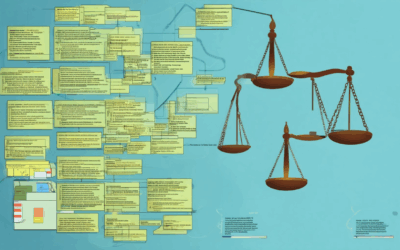In today’s fast-paced world of business and philanthropy, measuring social impact has become a cornerstone of responsible practices. Companies, non-profits, and organizations across industries are increasingly tasked with demonstrating the tangible effects of their initiatives on society. This intricate dance between mission-driven goals and measurable outcomes requires a sophisticated approach to tracking progress and assessing impact. At its core, social impact measurement is not just a buzzword—it’s a critical tool for accountability, learning, and growth.
This comprehensive guide dives deep into the intricacies of social impact measurement, offering a roadmap for anyone looking to understand and implement effective frameworks. From foundational theories to practical tools, we’ll explore how organizations can systematically evaluate their efforts and align them with broader societal goals. Whether you’re working in education, healthcare, or corporate responsibility, this guide provides actionable insights and real-world examples to empower your organization to measure what matters most.
By examining leading methodologies, evaluating cutting-edge tools, and analyzing case studies from diverse sectors, this article equips readers with the knowledge and strategies needed to conduct robust social impact analyses. We’ll also delve into the challenges of ensuring accuracy and reliability in measurements, providing practical solutions to enhance credibility and effectiveness. Ultimately, the goal is to empower organizations to not only measure impact but also use that data to drive meaningful change. Join us as we uncover the essential tools, frameworks, and best practices for successfully measuring social impact in any setting.
Key Takeaways
- SIM Theory Provides a Framework: Social Impact Measurement (SIM) theory offers a structured approach to evaluate and quantify the societal effects of social programs through economic, environmental, and social metrics.
- Frameworks Facilitate Measurement: Key frameworks like the Social Impact Assessment (SIA) and Social Return on Investment (SROI) enable organizations to measure and value social and environmental returns alongside financial performance.
- Essential for Nonprofits: Social impact measurement is crucial for nonprofits to demonstrate accountability and effectiveness, helping them track progress and communicate their mission-driven impact to stakeholders.
- Tools Streamline Processes: Organizations can utilize tools like NPO Expert, Impact, and Roots to simplify the measurement of social impact, making the process more efficient and accessible.
- Understanding Social Influence: The social impact theory illustrates how social relationships and trusted peers significantly influence individual behavior and attitudes, shaping perceptions and actions.
- Comprehensive Analysis Steps: Conducting a social impact analysis involves defining clear objectives, engaging stakeholders, selecting appropriate frameworks (such as SIA or Triple Bottom Line), and systematically gathering and analyzing data to inform strategic decisions.

Example of Social Impact Measurement
An effective example of social impact measurement involves organizations tracking measurable outcomes that align with their mission goals. Consider a non-profit focused on reducing homelessness through employment programs:
- Job Placement Rate : Track the number of individuals successfully placed into jobs within a specified timeframe.
- Housing Stability : Measure how many participants transition into stable housing environments.
- Volunteer Engagement : Count the total hours of community service completed by program participants.
- Economic Impact : Assess the overall economic contribution generated by the employment programs, such as reduced public assistance reliance.
These metrics allow organizations to quantify their social impact, demonstrating tangible progress toward their objectives. By regularly monitoring and reporting on these measurements, non-profits can better understand their effectiveness and adjust strategies accordingly.
How Companies Measure Social Impact
To effectively measure social impact, companies employ a combination of quantitative and qualitative methods. These approaches allow for a holistic understanding of their societal contributions and outcomes.
Key Metrics for Social Impact Measurement
- Quantitative Metrics
- Number of People Impacted : Tracks the scale of influence, such as the count of beneficiaries in education programs or community development initiatives.
- Environmental Metrics : Includes carbon footprint reduction, waste diversion rates, and energy efficiency improvements.
- Economic Impact : Assesses job creation, revenue generated, and economic multipliers through social enterprises.
- Qualitative Metrics
- Community Feedback : Collects surveys and testimonials to gauge program effectiveness and community satisfaction.
- Partnership Analysis : Evaluates collaboration strength with stakeholders like NGOs, governments, and businesses.
- Behavioral Change : Measures shifts in individual attitudes or behaviors resulting from social interventions.
Data Collection Methods
- Surveys and Questionnaires : Directly engage with stakeholders to gather perceptions and feedback.
- Program Monitoring : Use standardized tools to track progress against set goals and objectives.
- Impact Assessments : Conduct regular evaluations to measure long-term effects of social initiatives.
Industry Frameworks and Tools
- Social Impact Measurement Framework (SIMF) : A widely adopted framework that helps organizations systematically measure their social impact across various dimensions.
- Impact Assessment Rubric : Provides a structured approach to evaluate the reach, effectiveness, and sustainability of social programs.
- Nonprofit Effectiveness Initiative (NEI) : Offers metrics and tools for assessing program outcomes and broader societal impacts.
Common Challenges and Solutions
- Data Discrepancies : Address inconsistencies between quantitative and qualitative data through triangulation and mixed-methods approaches.
- Complexity of Outcomes : Simplify measurement frameworks to focus on key indicators while still capturing nuanced impacts.
- Resource Constraints : Utilize cost-effective tools and partner with external evaluators to enhance measurement capabilities without overwhelming budgets.
Competitor Insights
Explore additional resources from industry leaders:
- Sopact – Specializes in social impact measurement software and frameworks.
- Impaakt – Provides tools and services for measuring and reporting social impact.
- GivingSphere – Focuses on transparency and impact reporting for global initiatives.
By combining these strategies, companies can accurately measure and communicate their social impact, fostering trust and accountability with stakeholders.

Example of a Social Impact Assessment
A social impact assessment (SIA) evaluates how a proposed change—such as a new policy, program, or development project—affects society. It examines potential impacts on individuals, families, communities, and broader societal systems. Below is an example of how an SIA might unfold:
Example Scenario: New Housing Development
A city government proposes building a low-income housing complex to address housing shortages. To assess the social impact, they conduct interviews, surveys, and focus groups with current residents, potential beneficiaries, and community stakeholders.
Key Areas Assessed:
- Family Dynamics : How does affordable housing affect family structures and relationships?
- Community Engagement : Does the development foster stronger community ties or introduce new dynamics?
- Mental Health : Are there improvements in mental health due to reduced housing stress?
- Economic Impact : How does the development affect local businesses and employment opportunities?
- Cultural Preservation : Are there concerns about preserving the unique culture of the area?
Findings:
- Improved mental health and reduced homelessness among residents.
- Strengthened community networks through shared spaces and events.
- Economic boost from increased foot traffic and local entrepreneurship.
- Potential loss of historical character due to modern architecture.
Recommendations:
- Incorporate community input into design decisions.
- Provide ongoing support services to help residents transition smoothly.
- Balance economic benefits with cultural preservation efforts.
This process ensures that decision-makers consider both quantitative data and qualitative insights to create outcomes that align with community needs and values.
For further reading on conducting impactful assessments, explore resources like NPO Expert ‘s guides on community impact analysis and program evaluation.

What is the Social Impact Measurement Theory?
The Social Impact Measurement (SIM) theory is a conceptual framework used to evaluate and quantify the effects of social programs and initiatives on society. It focuses on assessing how interventions contribute to positive societal outcomes, often measured through various indicators such as economic, environmental, and social metrics.
Theoretical Foundations
The SIM theory is rooted in several key theories and models within the social sciences. One prominent approach is the Social Value Bank , developed by Michael West, which categorizes social outcomes into seven domains: health, education, environment, economy, justice, and community. Another influential model is the Theory of Change , which emphasizes understanding how actions lead to desired outcomes over time.
Common Frameworks
Several frameworks have emerged to operationalize the SIM theory. The Social Impact Assessment (SIA) is a widely used tool that identifies and quantifies the potential social impacts of policies, projects, or programs. The Social Return on Investment (SROI) framework, developed by Nicki Pfeffer and John Friend, provides a methodology to measure and value social and environmental returns alongside financial ones.
Importance for Nonprofits
For nonprofit organizations, SIM is crucial for demonstrating accountability and effectiveness. It allows NGOs to track progress toward their mission goals and communicate their impact to stakeholders, including donors, policymakers, and the public. However, implementing SIM effectively requires careful planning and resources.
Tools and Resources
To support organizations in measuring social impact, various tools and platforms are available. NPO Expert offers valuable resources tailored for nonprofits, including guides on social impact measurement and case studies highlighting successful implementations. Other platforms like Impact and Roots also provide tools and frameworks to simplify the process.
By leveraging SIM theory and available frameworks, organizations can better understand their social impact, align their efforts with broader societal goals, and communicate their contributions effectively.
What is an example of a social impact theory?
The social impact theory in psychology posits that individuals are influenced by the behaviors and attitudes of those around them, particularly those they trust and interact with frequently. This theory emphasizes the role of social relationships in shaping behavior and attitudes.
An example of the social impact theory can be observed in many everyday situations. For instance, consider a workplace where employees are encouraged to adopt healthier habits. If a colleague consistently exhibits positive behavior, such as eating healthily and exercising, this can influence others to follow suit. The social impact theory suggests that observing others’ behaviors and attitudes leads to a desire to conform, often without deliberate intention.
This phenomenon can also extend to online platforms, where individuals are influenced by the content shared by their friends, family, and communities. The theory highlights how social connections and interactions shape perceptions and actions, reinforcing norms and encouraging collective behavior.
To further understand the social impact theory, you can explore resources on NPO Expert, which provides insights into how social dynamics influence decision-making and behavior in various contexts: NPO Expert .

How to Conduct a Social Impact Analysis
To perform a social impact analysis effectively, follow these organized steps:
- Define Clear Objectives : Establish specific, measurable goals aligned with your organization’s mission and values. This ensures your analysis remains focused and relevant.
- Engage Stakeholders : Identify and involve key stakeholders such as clients, employees, partners, funders, and community members. Their input ensures a balanced and comprehensive analysis.
- Choose the Right Framework : Select a framework like the Social Impact Assessment (SIA) model or the Triple Bottom Line (TBL) approach. SIA focuses on economic, environmental, and social impacts, while TBL considers people, planet, and profit.
- Select Tools and Software : Utilize tools like surveys, focus groups, and data analytics software. Combine qualitative and quantitative methods for a holistic view and leverage digital platforms for efficient data management.
- Collect and Analyze Data : Gather data through surveys, interviews, and focus groups. Use statistical tools to measure trends and correlations, ensuring data completeness and bias mitigation.
- Report Findings : Present results clearly, using visual aids like charts and graphs. Highlight both positive and negative impacts and suggest areas for improvement in your strategies.
- Monitor Continuously : Regularly review findings with stakeholders and update strategies based on feedback to maintain dynamism and responsiveness.
- Consider Ethical Issues : Ensure the analysis respects privacy and avoids harm. Address negative impacts proactively.
- Integrate into Strategy : Systematically incorporate the analysis into decision-making processes to inform long-term goals and strategies.
By following these steps, organizations can gain insights into their social impact, fostering informed decisions to enhance societal benefits.





0 Comments